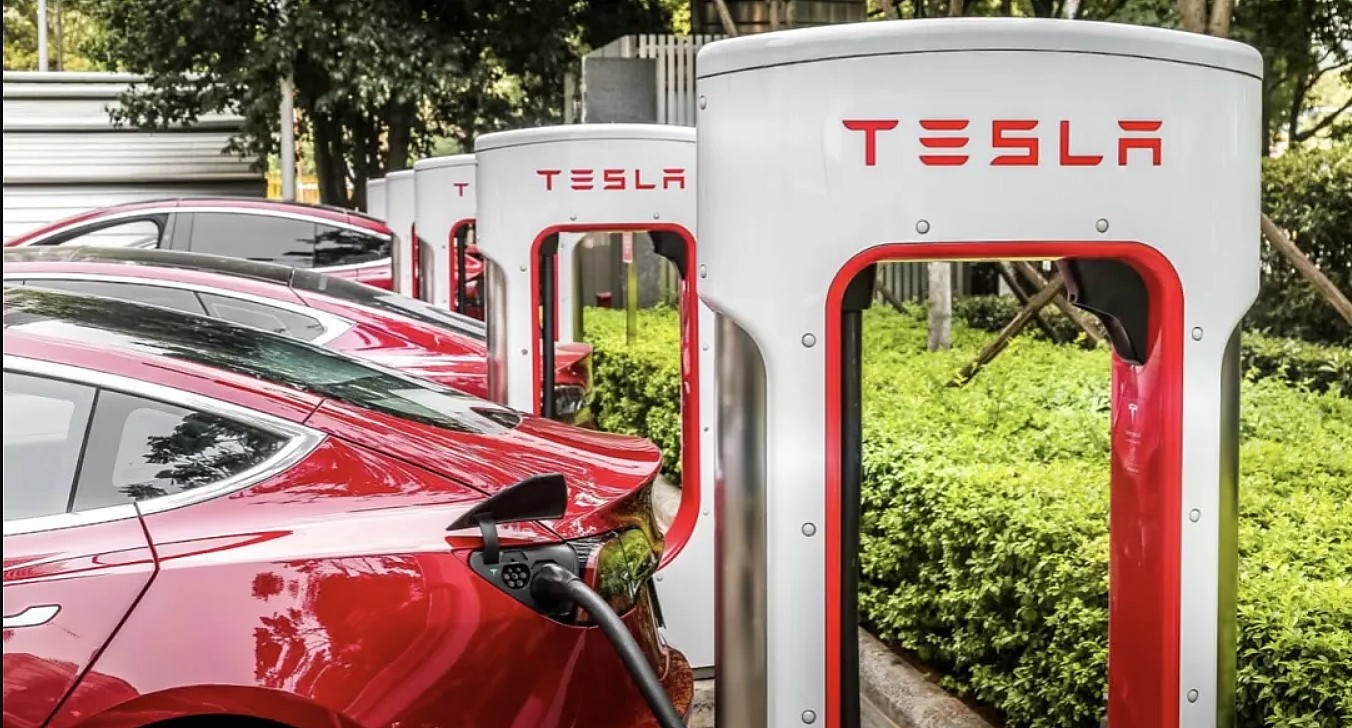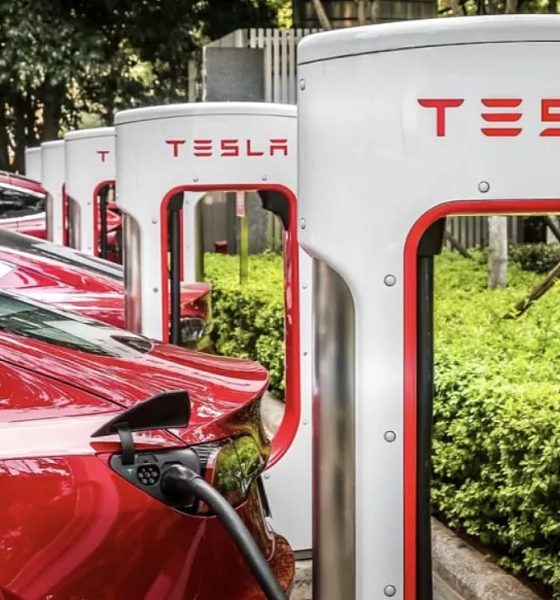

Investor's Corner
Tesla highlights Morgan Stanley’s EV sector strengths by outselling OEM competitors
Tesla (NASDAQ: TSLA) highlights a new Morgan Stanely note that reveals a slowly developing and recovering combustion engine sector, along with growing electric vehicle numbers compared to 2020. The note, headed by analyst Adam Jonas, reflects Tesla’s strengths in a sector that is still growing but becoming more concentrated and competitive nearly every quarter as OEMs fight to dethrone the undisputed champion of the EV sector.
Examining figures out of the traditional dealership model indicates that consumers may be dealing with automotive inflation, which could contribute to low-end sales and inventory figures despite strong demand. Jonas writes that selling days were up one day to 27 total days this year in July, compared to 26 days in 2020. However, inventory is “hovering at record low levels,” with three fewer days of supply than last year. Some OEMs are struggling with even larger deficits, however. Ford is estimated to have 36 days of inventory, down 50% compared to last year’s 72 days of inventory. Stallantis is down to 35 days from 60 days last year.
The root cause of the drop could be attributed to several factors, including the ongoing semiconductor shortage that continues to stump automakers. Basic features like “push-to-start” in ICE cars are being eliminated to conserve semiconductor chips. Additionally, a transition in the preferred powertrain of consumers may also be happening, based on Tesla’s increasing sales data points, which include nominal sales, total market share, EV sector penetration, and basic sales figures.
Morgan Stanley on Autos & Shared Mobility ??
“Tesla nominal sales estimated to have grown +66% y/y”
“Tesla’s 26,200 estimated US sales compares to the rest of the OEM BEV
US sales of 14,379. Tesla appears to be outselling the rest of the OEMs in
BEVs by ~1.8x.”$TSLA pic.twitter.com/FvnqhXxPsx— David Tayar (@davidtayar5) August 4, 2021
Jonas said in the note that total industry sales on a selling day for ICE vehicles were +0.8% year-over-year, while BEV sales were up +98.5% year-over-year.
Tesla continues to be the EV maker with the most impressive sales statistics. In July, Tesla’s estimated 26,200 U.S. sales outshine the 14,379 total BEV sales from OEMs during the month. Outselling the world’s largest automakers by around 1.8x, it is no surprise Tesla continues to help grow the sector altogether, achieving the well-known company goal of “accelerating the world’s transition to sustainable energy.”
July 2021’s BEV penetration was 3.1%, nearly double that of the same month last year at 1.6%. With more competitors and models from other manufacturers in the United States, especially with the Chevy Bolt EV and Ford Mustang Mach-E, Tesla’s market share has decreased from 80% last year to just 65% in 2021, still making up the majority of U.S. EV sales. The increased competition is not unwelcomed, especially as the concentration of the EV sector is continuing to grow at a rate that should have ICE manufacturers slightly concerned.
After reporting the best quarter in company history in production and deliveries in Q2, Tesla extended its streak of profitable quarters to eight straight after beating Wall Street consensus estimates. With the emerging EV sector in the United States, Tesla is at the forefront and outsells competing automakers at a generous rate. The company’s robust July sales figures point toward more domination from Elon Musk’s company, while OEM figures show promise moving forward.
Disclosure: Joey Klender is a TSLA Shareholder.
Don’t hesitate to contact us with tips! Email us at tips@teslarati.com, or you can email me directly at joey@teslarati.com.

Investor's Corner
Tesla stock closes at all-time high on heels of Robotaxi progress

Tesla stock (NASDAQ: TSLA) closed at an all-time high on Tuesday, jumping over 3 percent during the day and finishing at $489.88.
The price beats the previous record close, which was $479.86.
Shares have had a crazy year, dipping more than 40 percent from the start of the year. The stock then started to recover once again around late April, when its price started to climb back up from the low $200 level.
This week, Tesla started to climb toward its highest levels ever, as it was revealed on Sunday that the company was testing driverless Robotaxis in Austin. The spike in value pushed the company’s valuation to $1.63 trillion.
Tesla Robotaxi goes driverless as Musk confirms Safety Monitor removal testing
It is the seventh-most valuable company on the market currently, trailing Nvidia, Apple, Alphabet (Google), Microsoft, Amazon, and Meta.
Shares closed up $14.57 today, up over 3 percent.
The stock has gone through a lot this year, as previously mentioned. Shares tumbled in Q1 due to CEO Elon Musk’s involvement with the Department of Government Efficiency (DOGE), which pulled his attention away from his companies and left a major overhang on their valuations.
However, things started to rebound halfway through the year, and as the government started to phase out the $7,500 tax credit, demand spiked as consumers tried to take advantage of it.
Q3 deliveries were the highest in company history, and Tesla responded to the loss of the tax credit with the launch of the Model 3 and Model Y Standard.
Additionally, analysts have announced high expectations this week for the company on Wall Street as Robotaxi continues to be the focus. With autonomy within Tesla’s sights, things are moving in the direction of Robotaxi being a major catalyst for growth on the Street in the coming year.
Elon Musk
Tesla needs to come through on this one Robotaxi metric, analyst says
“We think the key focus from here will be how fast Tesla can scale driverless operations (including if Tesla’s approach to software/hardware allows it to scale significantly faster than competitors, as the company has argued), and on profitability.”

Tesla needs to come through on this one Robotaxi metric, Mark Delaney of Goldman Sachs says.
Tesla is in the process of rolling out its Robotaxi platform to areas outside of Austin and the California Bay Area. It has plans to launch in five additional cities, including Houston, Dallas, Miami, Las Vegas, and Phoenix.
However, the company’s expansion is not what the focus needs to be, according to Delaney. It’s the speed of deployment.
The analyst said:
“We think the key focus from here will be how fast Tesla can scale driverless operations (including if Tesla’s approach to software/hardware allows it to scale significantly faster than competitors, as the company has argued), and on profitability.”
Profitability will come as the Robotaxi fleet expands. Making that money will be dependent on when Tesla can initiate rides in more areas, giving more customers access to the program.
There are some additional things that the company needs to make happen ahead of the major Robotaxi expansion, one of those things is launching driverless rides in Austin, the first city in which it launched the program.
This week, Tesla started testing driverless Robotaxi rides in Austin, as two different Model Y units were spotted with no occupants, a huge step in the company’s plans for the ride-sharing platform.
Tesla Robotaxi goes driverless as Musk confirms Safety Monitor removal testing
CEO Elon Musk has been hoping to remove Safety Monitors from Robotaxis in Austin for several months, first mentioning the plan to have them out by the end of 2025 in September. He confirmed on Sunday that Tesla had officially removed vehicle occupants and started testing truly unsupervised rides.
Although Safety Monitors in Austin have been sitting in the passenger’s seat, they have still had the ability to override things in case of an emergency. After all, the ultimate goal was safety and avoiding any accidents or injuries.
Goldman Sachs reiterated its ‘Neutral’ rating and its $400 price target. Delaney said, “Tesla is making progress with its autonomous technology,” and recent developments make it evident that this is true.
Investor's Corner
Tesla gets bold Robotaxi prediction from Wall Street firm
Last week, Andrew Percoco took over Tesla analysis for Morgan Stanley from Adam Jonas, who covered the stock for years. Percoco seems to be less optimistic and bullish on Tesla shares, while still being fair and balanced in his analysis.

Tesla (NASDAQ: TSLA) received a bold Robotaxi prediction from Morgan Stanley, which anticipates a dramatic increase in the size of the company’s autonomous ride-hailing suite in the coming years.
Last week, Andrew Percoco took over Tesla analysis for Morgan Stanley from Adam Jonas, who covered the stock for years. Percoco seems to be less optimistic and bullish on Tesla shares, while still being fair and balanced in his analysis.
Percoco dug into the Robotaxi fleet and its expansion in the coming years in his latest note, released on Tuesday. The firm expects Tesla to increase the Robotaxi fleet size to 1,000 vehicles in 2026. However, that’s small-scale compared to what they expect from Tesla in a decade.
Tesla expands Robotaxi app access once again, this time on a global scale
By 2035, Morgan Stanley believes there will be one million Robotaxis on the road across multiple cities, a major jump and a considerable fleet size. We assume this means the fleet of vehicles Tesla will operate internally, and not including passenger-owned vehicles that could be added through software updates.
He also listed three specific catalysts that investors should pay attention to, as these will represent the company being on track to achieve its Robotaxi dreams:
- Opening Robotaxi to the public without a Safety Monitor. Timing is unclear, but it appears that Tesla is getting closer by the day.
- Improvement in safety metrics without the Safety Monitor. Tesla’s ability to improve its safety metrics as it scales miles driven without the Safety Monitor is imperative as it looks to scale in new states and cities in 2026.
- Cybercab start of production, targeted for April 2026. Tesla’s Cybercab is a purpose-built vehicle (no steering wheel or pedals, only two seats) that is expected to be produced through its state-of-the-art unboxed manufacturing process, offering further cost reductions and thus accelerating adoption over time.
Robotaxi stands to be one of Tesla’s most significant revenue contributors, especially as the company plans to continue expanding its ride-hailing service across the world in the coming years.
Its current deployment strategy is controlled and conservative to avoid any drastic and potentially program-ruining incidents.
So far, the program, which is active in Austin and the California Bay Area, has been widely successful.








